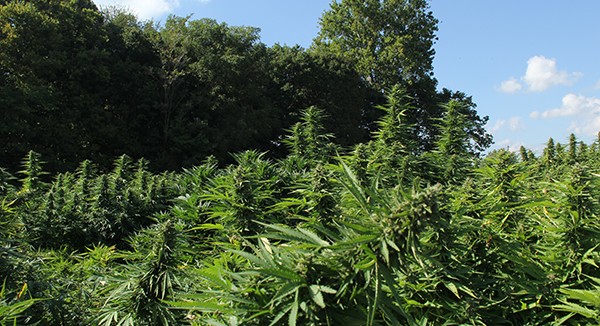CBD HEMP
 A hemp field plantation.
A hemp field plantation. Hemp grown for fiber, grain, oil, or seed stock production is going to differ from hemp-grown cannabinoids/essential oils most of the time.
Typically, hemp crops are planted at a rate of approximately 1000-2500 plants (sometimes higher) per acre either by direct seeding or by transplanting all-female clones or seedlings (typically feminized). This low density produces bushier plants that typically have more CBD per plant. However, there is another production model, where dioecious hemp seed is planted more like soybean or grain hemp. If you would like to learn more about this novel production model, please watch this video.
Growers will need to choose between clones, seedlings, or seeds. Clones should be identical, so people favor them for uniformity. However, they lack a taproot, so they may not do as well outdoors. Clones with a strong root network should provide stability to the plant. Seedlings should have a strong taproot which can help with pulling nutrients and water from deeper in the soil but will be less homogeneous. There can be many phenotypes in a bag of hemp seed. Direct seeding of feminized seeds can be costly and is generally not recommended. People have direct seeded with success, but wet weather can make this risky because seeds are susceptible to damping off. A grower should also consider how much they want to spend and what equipment they have access to for planting. Clones are the most expensive option, seedlings are the cost of the seed plus whatever a greenhouse charges to start them. Both of these require either transplanting equipment or hand planting.
There are a handful of different management practices when it comes to CBD production, but the ideal method is the one that works best for your current farming operation. Plasticulture is an option, but you can grow healthy plants without plastic. Plastic offers the advantage of either cooling (white plastic) or warming (black plastic) the soil. Plastic also reduces weed competition within rows.
When considering genetics for cannabinoid production, be mindful that if something sounds too good to be true, it probably is. Be cautious of high CBD content claims (>10%) while still being THC compliant. Certificate of analysis should be provided with the genetics you are purchasing, call the lab that did the testing and confirm the results. There are University-based testing results that are publicly available, like this sheet from Indiana (PDF) and this Midwest Cannabinoid Database. Ask the producer about what daylength induces flowering, it can and does differ across cultivars. You can use this tool to understand when during the season you would likely see flowering production begin.
Transplanting can be done with waterwheels, tobacco setter, or by hand. When transplanting, ensure that there is good soil to root contact. Before transplanting, ensure that your plants have been hardened off by the plant provider or that you have hardened them off.
Irrigation is worthwhile to investigate if you are in an arid climate or have sandy soils and have struggled with drought in the past. Drip irrigation is the most common method to deliver water to cannabinoid plants, but overhead irrigation is also an option. Overhead irrigation can increase the potential for pathogen growth later in the season when flowers are developing.
Cannabinoids and terpenes are produced in the glandular trichomes which are found in the highest concentration on the female flowers but are also found on leaves and stems. Male hemp plants should be eliminated if growing in an all-female system. Seed set can severely drop the cannabinoid content of these plants.
CBD producers are concerned about heavy metals in their fields. There have been several studies that demonstrate the ability of hemp to pull heavy metals out of the soil (see references at end). Certain plants can tolerate different contaminants in soil and have been used for phytoremediation (see more) It is unclear the level of heavy metal contamination that would require remediation before planting hemp for CBD. Because raw CBD flower goes through extraction and concentration, small amounts of heavy metals may rise to toxic concentrations. CBD products are ingested, so there is a concern of causing illness among users. Some products do get tested for heavy metals, pesticides, and mycotoxins by extraction or distillation companies. Growers who are concerned about heavy metal contamination can get their soil tested. We are unsure of how high metals have to be in the soil to see carryover in finished products.
Soil Testing For Heavy Metals from NC State Extension
Harvest can be difficult to determine but growers will want to consider THC content as their plants mature. Currently, the most accurate way to determine harvest is to monitor both THC and CBD through third party lab testing. ISO certified labs include: ProVerde labs and Botanacor are two popular labs that do potency testing. Once flowering begins many growers send samples to labs every week to two weeks. Other Testing Labs
More links from University-based research can be found below:
- Wisconsin Hemp, Division of Extension
- Cornell Cals (School of Integrative Plant Scienice), Reports and Factsheets
- NC State Extension, Hemp Publications and Factsheets
References
- Angelova, V., Ivanova, R., Delibaltova, V., & Ivanov, K. (2004). Bio-accumulation and distribution of heavy metals in fibre crops (flax, cotton and hemp). Industrial crops and products, 19(3), 197-205.
- Linger, P., Müssig, J., Fischer, H., & Kobert, J. (2002). Industrial hemp (Cannabis sativa L.) growing on heavy metal contaminated soil: fibre quality and phytoremediation potential. Industrial Crops and Products, 16(1), 33-42.
